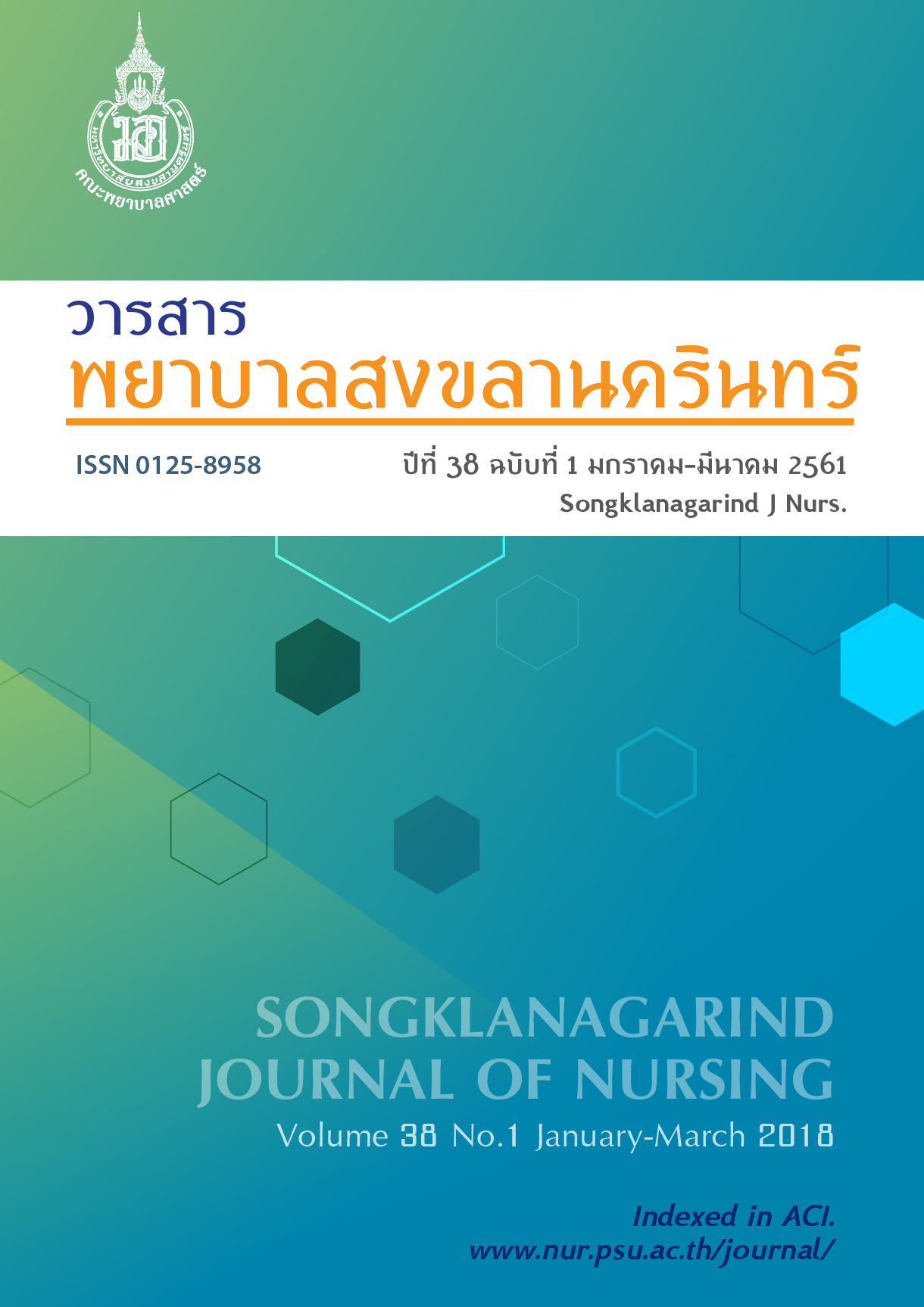Village Health Volunteers’ Knowledge, Attitudes, and Perceived Self-Efficacy in Providing Palliative Care for End-of-Life Patients
Main Article Content
Abstract
The objectives of this descriptive research were to examine the knowledge, attitudes, and perceived self-efficacy levels of village health volunteers providing palliative care for end-of-life patients and to compare the knowledge, attitudes, and perceived self-efficacy in providing palliative care for end-of-life patients among village health volunteers with different educational levels and work experiences. The samples were 245 village health volunteers who worked in KlongLuang Municipality, Prathumthani and were selected by using proportionate stratified sampling procedures. The data were collected using a questionnaire consisted of demographic form, knowledge, attitudes, and perceived self-efficacy in providing palliative care for end-of-life patients. The reliability of the knowledge questionnaire was tested using KR-20 and yield .89 The reliabilities of attitudes, and perceived self-efficacy in providing palliative care for end-of-life patients were examined using Cronbach’s alpha coefficients and yield .73 and .94, respectively. Descriptive statistics and the Kruskal-Wallis test were used for data analysis.
The study found that the village health volunteers had a moderate level of knowledge (M=13.59, SD=2.39), a moderate level of attitudes (M=2.81, SD=0.23), and a high level of perceived self-efficacy in providing palliative care for end-of-life patients (M=3.17, SD=0.50). In terms of education level, no statistically-significant difference was found in the village health volunteers’ knowledge and perceived selfefficacy in providing palliative care for end-of-life patients. In terms of attitudes, statistically-significant difference was found in providing palliative care for end-of-life patients. There was no significantly different among village health volunteers with different experiences on palliative care for end-of-life patients regarding to knowledge, attitudes and perceived self-efficacy.
Nurses and other healthcare providers should promote village health volunteers to enhance their knowledge and their attitudes on palliative care, to maintain their perceived self-efficacy on palliative care
and to provide end of life patients in communities more effectively.
Article Details
References
2. Bureau of Policy and Strategy, Office of Permanent Secretary.Public Health Statics [Internet]. Bangkok: Ministry of public health; 2015 [cited 2016 Mar 23]. Available from: http://bps.moph.go.th/new_bps/sites/default/files/health_statistic2558.pdf
3. Kurat S, Parakho P, Suwannakoat S. Palliative care: Nurse’s role in end of life care [Internet]. Bangkok: SiMahaSarakham Nurse College, Ministry of public health; 2015 [cited 2016 Jun 30]. Available from: http://www.smnc.ac.th/group/research/images/stories/end%20of%20life.pdf
4. World Health Organization. Fact sheet on palliative care 2017 [Internet]. [cited 2017 Aug 25]. Available from: http://who.int/mediacentre/factsheets/fs402/en/
5. Nursing and Midwifery Council. The National Health Commission Office, The Nurse’s Association of Thailand. The course training’s village health volunteer of palliative care for the end of life patients and Manual. Bangkok: Judthong; 1013. Thai.
6. Thanapop S, Kwanchuea R. The need of palliative care for the end-of-life chronic patients in a community: A case study of a primary care unit/network. The Public Health Journal of Burapha University. 2015; 10(2):13-25. Thai
7. Fernandes R, Braun K, Ozawa J, et al. Home-based palliative care services for underserved populations. J Palliat Med. 2010; 13(4): 413-9. doi:10.1089/jpm.2009.0216.
8. Department of Medical Services. Palliative care 2014 [Internet]. Bangkok: Ministry of Public Health [cited 2016 Jan 10]. Available from: http://www.dms.moph.go.th.
9. Ruansri P, Pothiban L, Nanasilp P. Knowledge, attitudes, and practices among health care personnel pertaining to terminal care for older patients with chronic illness. Nursing Journal. 2015; 42(2):24-35.Thai
10. Chukaew S, Sirapo-ngam Y, Prapaipanich W. Knowledge, attitude and practice perceived by nurses in helping and promoting caregivers’ health. Rama Nurs J.2012; 18(2): 126-40. Thai
11. Hanprasitkam K, Patoomwan A, Churaitatsanee S, et al. The effect of an end-of-life care education program on nurses’ knowledge, attitude, and practice in caring for end-of-life patients. Rama Nurs J. 2011; 17(1):126-40. Thai
12. Luvira V, Srikha P, Pairojkul S. Community-based palliative care by volunteers: Perceptions of village health volunteers in a community of KhonKaen Province. Srinagarind Med J. 2013; 28(2):199-240. Thai
13. Bandura A. Self-efficacy: The exercise of control. New York: W.H. Freeman and Company; 1997.
14. Prombutr P, Sookpool A, Phinyo K, et al. The effect of self-efficacy program toward knowledge and self-efficacy of village health volunteers in diabetic and hypertension patient care in community in northeast province. Songklanagarind J Nurs.2015; 35(2):113-28. Thai
15. Division of Public Health, Khlongluang Municipality. Generality and basic data document [Internet]. Bangkok: Administrative Municipality’s Khlongluang; 2015 [cited 2016 May 8]. Available from: http://www.khlongluang.go.th/
16. Yamane T. Statistics, an introductory analysis. 2nd ed. New York: Harper and Row; 1967.
17. Bloom BS. Taxonomy of education objective, handbook I: Cognitive domain. NewYork: David Mackay; 1984.
18. Rodsom A, Kijsomporn J, Howharn C. Knowledge and practice on palliative care among trained health workers. Journal of Health Science. 2015; 24(3):468-78. Thai
19. Maneesri R, Prasertsri N, Pradubthong O. Undergraduate nursing students’ knowledge and attitudes regarding pain management. Journal of Nursing Division. 2012; 39(2):66-78. Thai
20. Shahnazi H, Saryazdi H, Sharifirad G, et al. The survey of nurse’s knowledge and attitude toward cancer pain management: Application of health belief model. J Educ Health Promot. 2012; 1:1-4. doi:10.4103/2277-9531.98573
21. Srimunta T, Trongdee T. Euphemism in contem porary Thai and Mandarin Chinese. Chophayom journal.2013; 24:3-19.Thai
22. Srisuwan N, Matchim Y, Nilmanat K. Nurses’ competency in communication with patients at the end of life and their families and related factors. Songklanagarind J Nurs. 2014; 34(3):109-124. Thai
23. Daodee S, Thai nurses’ caring behaviors: Dying patients’ care. Journal of Nursing Science Naresuan University.2008; 2(2):62-78. Thai
24. Pokpalagon P. Palliative care model in Thailand. Nursing Journal of the Ministry of Public Health. 2016; 26(3):41-51. Thai.

